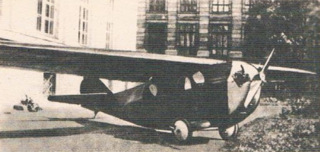Related Research Articles

The RWD 1 was a Polish sports plane of 1928, a single-engine high-wing monoplane constructed by the RWD design team.

The BFW M.20 was a German single-engine, high-wing monoplane ten-seat passenger transport aircraft, developed in the late 1920s and early 1930s. Deutsche Luft Hansa used it throughout the 1930s on a variety of routes.

The ICAR 36 / ICAR Comercial (sic), variously also known as the ICAR M 36, Messerschmitt M 36 or BFW M.36, was a Messerschmitt design built and tested by the Romanian company ICAR in the mid-1930s. It was a small, single-engine high-wing airliner, the first civil transport aircraft built in Romania.

The BFW M.23, sometimes known as the Messerschmitt M 23, was a 1920s two-seat sporting aircraft designed by Willy Messerschmitt, and produced by Bayerische Flugzeugwerke (BFW). Examples won several prestigious races in 1929 and 1930.

The BFW M.35, sometimes known as the Messerschmitt M 35, was a German sports plane of the early 1930s. It was the last of a line designed by Willy Messerschmitt.

The BFW M.27, sometimes known as the Messerschmitt M.27, was a German two-seat sports plane with a low, cantilever wing, open cockpits and a fixed undercarriage sold in small numbers at the start of the 1930s.

The BFW M.31, sometimes known as the Messerschmitt M.27, was a radial-engined German two-seat sports plane from 1932, with a low, cantilever wing, open cockpits and fixed undercarriage. Only one was built.
The BFW M.29 was a single-engine two-seat low-wing aircraft, designed by Willy Messerschmitt for the 1932 Circuit of Europe races.

The Gloster Goring was a single-engined two-seat biplane designed to meet 1926 Air Ministry specifications for a day/torpedo bomber. It was not put into production and the one aircraft built served later as an engine testbed.

The BFW M.21 was a single-engined biplane trainer designed by Willy Messerschmitt for the German Ministry of Transport. It was one of only two biplanes Messerschmitt designed, neither reaching production.
The BFW M.22 was a twin-engined medium bomber, designed by Willy Messerschmitt for the German Ministry of Transport. It was one of only two biplanes Messerschmitt designed, both unsuccessful.
The BFW M.26 was a single-engined cantilever-winged monoplane light airliner built in Germany in 1930. There were no sales and only one was built.
The Saynor & Bell Canadian Cub was a single engine, single seat parasol wing monoplane, designed and built in Canada in 1930. It was intended to be a simple and economical vehicle with which pilots could increase their flying experience. It was destroyed on take-off after a few months of flight and no more were built.

The Farman Moustique is a family of French monoplanes built by the Société des Aéroplanes Henry et Maurice Farman at Billancourt.

The Caudron C.67 was a simple single seat biplane with a low powered engine. It was built and flown in France in 1922.
The Caudron Type K was a French floatplane with a very powerful, twenty cylinder radial engine in pusher configuration. It took part in a French seaplane competition in 1913, but was lost in a take-off accident during the competition.

The Caproni Ca.95 was a large, three engine, long range, heavy bomber prototype built in Italy in 1929. It could carry a 1,600 kg (3,500 lb) bomb load and had three defensive gun positions. Only one was built.

The Lachassagne AL 5 was a French low power, single seat sports aircraft with novel, in-flight variable camber wings and tailplane. It first flew in 1930; at least two were built.
The Medwecki and Nowakowski M.N.3 or just M.N.3 was a low-powered, four seat, Polish aircraft flown in 1928. The sole example was modified into a more powerful two-seater which served aeroclubs until World War II.
The Ścibor-Rylski ŚR-3 was a Polish, ultralight, low power, single-seat sports aircraft. First flown in August 1939, only one was completed before World War II.
References
- Citations
- 1 2 3 4 Smith 1971 , p. 18
- Cited sources
- Smith, J Richard (1971). Messerschmitt an aircraft album. London: Ian Allan. ISBN 0-7110-0224-X.